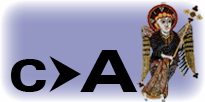For over three decades, the choir of the Church of Notre Dame sang Renaissance polyphony and Gregorian chant. During my twelve years as organist & choirmaster, we employed the following musical & liturgical approach:
Gregorian chant
- We sang the Introit chant in Latin, in four-voice settings by me - see Introit Project in the catalog. The chants, which are unaltered in the settings, came from the Graduale Romanum.
- Additionally, I would chant the Communion Antiphon (Latin antiphons from the Gregorian Missal, with English verses from the Simple English Propers) while the choir received the Eucharist.
Renaissance polyphony
We sang motets at Offertory and Communion, usually in Latin and occasionally in English. (The Communion motet immediately follows the Communion Antiphon.)
Our parish used the Ordinary Form of the Roman Rite (formerly known as the Novus Ordo), which permits a wide range of musical options. My approach to selecting music was a combination of the prescribed and the pragmatic: "prescribed" in that I tried to select pieces always textually suitable to the day's liturgy; "pragmatic" because my vocal forces varied a lot from year to year (sometimes from week to week!), and so I couldn't necessarily repeat what we did at a previous iteration of this Sunday's liturgy. It would often take hours to find the right pieces to fulfill both criteria.
- I began with the Propers - the texts of that particular liturgy. Using the Gregorian Missal as my primary source, I'd look up the prescribed Offertory and Communion chants. Are there polyphonic settings of those texts? If so, do they fit the voicing of my current ensemble?
- If not, I'd look at the other prescribed chants (the Gradual, and the Alleluia or Tract), and consider the use of those texts at an alternate placement in the Mass. Are there polyphonic settings of those? If so, do they fit the voicing of my current ensemble?
- If not, I'd then peruse the day's readings. Often there are musical settings of the psalm found in that day's Responsorial Psalm. Sometimes there are settings of an excerpt from the day's Gospel Reading, or occasionally from one of the other readings. Can I find a setting of a text from the day's readings? If so, does it fit the voicing of my current ensemble?
- Many Renaissance motets have two large sections, a prima pars (first part) and secunda pars (second part). If the complete text is fitting, I'd often use the prima pars at Offertory and the secunda pars at Communion.
- When possible, I like to feature the same composer at Offertory and Communion, to maintain some aesthetic unity within the Mass. When that won't work, I try to pair composers from similar places (e.g. Guerrero and Victoria, or Parsons and Byrd). If I'm going to do one motet in English, then I'll try to find another piece in English for the second motet, as well - again, trying to preserve a sense of unity within the liturgy's music.
- If I was a little stuck, I would sometimes pick a eucharistic text to use as the communion motet (Ave verum corpus, Caro mea, Ego sum panis vivus, O sacrum convivium, etc. - see the list at the bottom of p. 391 of the Graduale Romanum), and try to find a suitable complement for Offertory - either on a text thematically related to the day's readings or Propers, or with a similar compositional approach, as described above.
What the choir Mass would not have
- There was no opening hymn - we sang the Introit chant instead.
- There was no Offertory hymn - we sang a motet instead.
- There was no Communion hymn - we sang the Communion Antiphon followed by a Communion motet instead.
What? No hymns? Then what do the people sing? How does the congregation fulfill the Second Vatican Council's mandate of actuosa participatio (full and actual participation in the liturgy)?
We would include a closing hymn after the final blessing - but that's after the Mass is over. During the Mass the people were invited to sing
- the Ordinary (Kyrie, Gloria, Sanctus, Agnus Dei),
- and the responses and acclamations (refrain of the Responsorial Psalm, refrain of the Gospel Acclamation, the Mysterium fidei, and the Great Amen).
- In many parishes the people sing the Pater noster (Our Father), but in ours it was spoken. Neither I nor the priests I served were particular fans of the ubiquitous 1964 chant-nouveaux Our Father, cited by Thomas Day as the single piece of music that American Catholics will reliably sing in a Mass anywhere. This is one of the great ironies of contemporary Catholicism - that a piece that sounds like chant, that establishes some sort of tie to the great musical traditions of the last two millennia, and yet in fact is not authentic chant, should be the single most-sung piece in today's church...
- During the choral moments (Introit, Offertory, Communion) as the liturgy continues to unfold, the actuosa participatio of the people comprises listening, being inspired by beauty to pray to the Author of all beauty, and to contemplate the texts being offered (prayed!) by the choir.
A vitally important item is to include translations of all Latin texts in Mass bulletins. While Latin is the language of the universal Church, it is no longer a universally familiar language. One way to encourage actual participation is to ensure that everyone (singers and congregation) knows the texts of what's being sung, for understanding and contemplation. Otherwise, Latin can be experienced as remote and off-putting.
The point of all of this laborious searching is two-fold:
- We want to sing beautiful, liturgically appropriate pieces at Mass.
- We do not sing as a performance, but rather as prayer. We pray, through singing, for ourselves and our intentions, and for the congregation in the church with us. In fact, we're part of the congregation, just set aside for particular musical duties. And our music is meant to inspire the congregation, to help them consider the heavenly mysteries, and to get them to pray. If people aren't praying, then we're doing something wrong.
The lists of choral repertoire that follow primarily comprise the Offertory and Communion motets we employed during my time at Notre Dame. I've indicated the Mass setting for each season (we typically use different music for Advent, Christmas, Lent, Easter, and Ordinary Time). I hope that these listings may be useful to you in your own search for choir music that is fitting for Our Lord.
 |
 |
 |
| 2010-2011 | ||
| 2007-2008 | 2008-2009 | 2009-2010 |
| 2004-2005 | 2005-2006 | 2006-2007 |
| 2001-2002 | 2002-2003 | 2003-2004 |
| 1999-2000 | 2000-2001 |
Artwork for the evangelists by Lesley and Brian Davies.
